N° 5
May 2020
—
TTS Italia is the Italian ITS Association founded with the aim to promote the development and deployment of Intelligent Transport Systems (ITS) in Italy. |
|
|
|
|
|
|
Strategies for restarting Stefano Brinchi, president and CEO of Roma Servizi per la Mobilità
More information for users, clean vehicles, cycle paths, technology and smart working are the basis from which mobility in Rome restarts after the lockdown due to Covid-19. In this interview with TTS Italia, Stefano Brinchi, president and CEO of Roma Servizi per la Mobilità, tells how the capital is facing the restart, but also how this emergency can lead to consolidating healthy habits in the movement of citizens.

What are the measures that your city has put in place to deal with mobility in phase 2 in view of the resumption of work and commercial activities?
We have studied the various scenarios for a long time. Firstly, thought was given to how preventing the massive recourse to the private vehicle. With Covid risk, it is natural to think of the car or motorbike as "safe" vehicles from the health point of view. But we must consider the risk of traffic, traffic jams and smog. Once the public transport vehicles were adapted to the provisions on the distance between passengers, we set to work to offer valid alternatives. Starting with cycling. We have planned and are progressively planning and building together with the Mobility and Transport Department of Roma Capitale 150 km of transitory cycle paths that will converge towards the city center starting from various suburban quadrants. Often already existing sections of itineraries are joined, reserved for cycling. The first kilometers are already ready and we will gradually cover all the relevant areas. Through the mobility managers of the various companies, public and private, we then launched a campaign to offer non-Smart working workers to move in a sustainable way: using the bicycle, car sharing or car pooling. On the public transport front we have tried to compensate, as far as possible, the capacity of the vehicles with alternative measures: on the street, to strengthen the scheduled service, there will be private tourist buses. To prevent gatherings in the morning, in some cases the service will start at 4.30 in the morning.
Do you believe that the use of technological systems can help mobility in this phase of coexistence with the virus? If so, in which area? And with what times?
Yes, absolutely. Technology is the best ally of mobility also and above all in this delicate phase. Both from the point of view of the evolution of vehicles and from that of information to users. Let's think of the enormous progress made by electric vehicles, with two and four wheels. Anyone who doesn't trust getting on a bus or metro for fear of the virus can move on a bike or on a zero-emission car. Let's think about the usefulness of the Apps, such as our Roma Mobilita, which provide citizens with real-time information on the frequency of public transport. If a citizen knows exactly when a bus passes, he arrives at the stop just a few moments earlier. In this way dangerous gatherings are avoided.
In your opinion, in this crisis are there opportunities to be seized for a radical digital shift in passenger and freight mobility in Rome?
I am convinced that the Romans will make a virtue out of necessity. The forced habit of using the Apps will become common use. In these months, those who did not appreciate it will understand the usefulness of technological means and will no longer be able to do without it. It will be unthinkable, for most citizens, to wait for the bus at the stop without knowing the time of passage from the smartphone. Just as many will discover even more the usefulness of booking a car sharing service or a ride on a car pooling through the phone. All of this puts the operators in the sector in front of a challenge: to offer users always functioning Apps constantly trying to develop and improve them.
Are there measures that could become structural, on which local and central government should invest in a coordinated way?
I hope for a structural adoption of Smart Working associated with a distribution of activities, for those who have to go to the office, at various times of the day. We have to overcome the concept of rush hour. If those who can work from home and those who have to go out do so in staggered times, we will have much less traffic. Precisely for this reason, in autumn 2019, well before the Covid emergency, we had signed an agreement with the universities of La Sapienza, Tor Vergata and Roma Tre to spread the start of lessons throughout the day. I hope this is the path on which, after the necessary regulatory adjustments, public and private realities will start.
Who is Stefano Brinchi. Born in 1974, he graduated in Civil Engineering-Transport in 2000 at the La Sapienza University of Rome with 110 cum laude. He held technical responsibility roles in Sta and Atac. Since March 2018 he has been president and CEO of Roma Servizi per la Mobilità.
Strategies for restarting / 2 Flexibility of public transport and innovation: this is how Verona starts up again
A seven-step plan guides the restart of Verona which focuses on the flexibility of the TPL, alternative mobility, electric and sharing, but without losing sight of innovation. "In this restart phase, the use of ITS systems – explains in this interview Bruno Pezzuto, Head of Communication and Telematic Systems, EU project and Smart City of the Municipality of Verona and Vice President of TTS Italia - in the context of mobility will be of fundamental importance for the flexibility that the Administration has asked for in relation to public transport in the face of changing demand."

Traffic changes before, during and after the lockdown
In fact, in the almost complete closing weeks, starting from February 24, Verona practically stopped. “The many indicators available to the Administration testify to this - says Pezzuto - starting from the vertical fall in public transport demand with the consequent contraction of vehicles in circulation (-85%) and the simultaneous reduction in vehicular traffic up to the minimum historical values (-90% compared to the normal employment rate).
But starting from May 18 (phase 2) the data clearly show an already growing traffic flow which, with immediate interventions, must prevent it from collapsing after two months of detention. It is unimaginable to think that the only vehicle used today could be the private car. No city can support such a road system, for this reason, in particular in urban areas, all possible solutions must be supported to guarantee active mobility, with alternative forms of movement.”
The Epidemiological Emergency Mobility Plan
The main measures taken by the Administration in view of the gradual reopening of the city starting from Monday 18 May are contained in the Epidemiological Emergency Mobility Plan and aim to guarantee health and safety in transport; fluidity of circulation; sustainable and alternative mobility with the establishment of ZONE 30 and new cycle paths.
Among the measures – explains Pezzuto - three are particularly important.
The remodeling of the public transport services according to the social distancing within the means of transport and to the foreseeable reduction in demand calculated by more than 50% less than normal values; in this perspective, the ability of the transport operator is absolutely relevant to make the service offered “flexible” on the basis of demand that will present significant variations take on particular importance.
The resumption of construction sites for the installation of new bike sharing stations in all areas of the city. The interventions, which had been suspended due to the health emergency, will thus lead to the completion of 20 new cycle stations, with the enhancement of 2 existing bike sharing stations and the construction of 18 completely new ones, in areas of the city in which they were not present. The new stations, in addition to being able to accommodate traditional bikes, will be able to recharge those with pedal assistance, thanks to a special control unit installed in the structure. Not surprisingly, 170 new traditional bikes and 150 e-bikes are arriving in the city, 50 of which have a seat for carrying children.
The return to full operation of the scooter rental business in order to increase the offer in the city electric micro mobility.
ITS for phase 2
Verona, that has long invested in technology, now aims to develop ad hoc solutions to manage phase 2.
“In recent years – says Pezzuto - the Administration has invested numerous funds for the implementation of the Integrated System for the management and monitoring of mobility and security in the urban area, implementing the Central Mobility and engaging the offices of the Mobility Directorate in some European projects that have enabled it to develop new technologies at the service of users.
In particular, with the POR-FESR 2014-2020 programs (€ 5 million), efforts are being made to further enhance both the technological systems and the infrastructure network of all the subsystems that make up the ITS of the City of Verona, bringing it to the levels of European cities of similar size and development; some of these loans are aimed at strengthening the telematic mobility management infrastructure with particular attention to public transport and planning and monitoring tools.
Attention must obviously be paid to implementing these programs according to the guidelines of the European Community for the development of ITS and C-ITS systems in favor of sustainable and alternative mobility.
Whit schools in September, the use of ITS systems in the context of public transport will be of fundamental importance for the flexibility that the Administration asks to operators in the face of changes in demand.
An exportable model
Is the mix of measures and technologies implemented by Verona exportable nationally?
“This pandemic on the one hand has put us to the test, especially in some areas of Italy where the social impact and the pain of human losses have been very strong, but on the other it has highlighted all our fragility, forcing us to make decisions quickly that we would never have made before, either politically or technically.
Cities must be able to invent sustainable, low-cost but above all alternatives to public transport itself until we can return to a new normality as someone now defines it at a socio-economic level. And the adoption of enabling technologies and the development of sensory networks in the urban context becomes a priority requirement if citizens are to be given the opportunity to move in a safe and flexible context.
All this will have to take place in a coordinated logic where the public sector will have to take on an increasingly coordinating role and not just a spectator, also from a technological point of view.”
|
|
|
SAVE THE DATE: ITS IN THE POST COVID – THE RESULTS OF TTS ITALIA SURVEY– WEBINAR – 11 JUNE 2020

The emergency linked to Covid-19 has been and still is an important test for digital, innovation and technology, in Italy as in the rest of the world. This unexpected and difficult situation in a short space of time has led our country to draw on a series of skills that have put institutions, businesses and individual citizens in front of the possibilities offered by technological innovation.
TTS Italia has always supported the crucial role that ITS play in terms of the country's competitiveness. In this regard, TTS Italia recently launched a survey with the aim of providing an effective contribution to the change underway in our society and in our production sector in particular, which more than anyone can contribute to facing the challenges of mobility in the post-Covid-19 scenario.
The free webinar which will take place on 11 June from 15.30 to 17.30 will be an opportunity to present the results of the survey and discuss it together with institutions, cities, industry, associations.
To register, click here.
Further details will follow. |
|
|
|
|
|
|
Targa Telematics is a tech company with 20 years of experience in connected vehicles, and develops high-tech solutions to enable companies, organizations, and communities to fully grasp the potential of the Internet of Things. Targa Telematics is a leader in the design and implementation of advanced digital platforms to connect devices, collect and analyze their data, and offer benefits to users through the use of Big Data, Analytics, Machine Learning and Artificial Intelligence. Smart cities and smart mobility are the main areas in which Targa Telematics operates. The company designs and implements services for ride sharing (cars, scooters, bicycles) with the aim of mitigating the environmental impact of transport and ensuring the best user experience, while promoting environmental sustainability. The company provides customers with complete and customized solutions to improve vehicle management efficiency, allow cost reductions, and the activation of new revenue sources, all while enabling cutting-edge services and business models with maximum levels of cybersecurity. With headquarters in Italy and offices in France and the UK, Targa Telematics collaborates with car manufacturers, short and long-term renters, financing and insurance companies, and offers high-tech solutions for ground handling vehicles at the largest airports worldwide.
www.targatelematics.com
—
PROJECT OF THE MOMENT
TARGA LITE
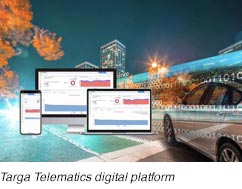 The core business of Targa Telematics is efficient fleet management. At the beginning of the year, a new solution was launched: Targa Lite. Through the use of telematics, Targa Lite allows fleet managers to highlight costs that are usually not able to be entered in accounting records, as well as wasteful spending associated with fleet use, in order to efficiently manage fuel supplies and optimize maintenance costs for the fleet itself. The advantage gained from its implementation is seen from the first two months of use: analyses have shown that a company can reduce wasteful spending by up to 20% with Targa Lite, in addition to having the tools to concretely evaluate the economic return on the investment.
Targa Lite is very simple to use and implement: just install the IoT device on fleet vehicles and enter the reference parameters on the web platform, allowing the fleet manager to use custom monitoring services. Targa Lite uses Internet of Things devices and Digital Mobility Platforms, the digital Targa Telematics platform that heavily relies on artificial intelligence, and machine learning based on big data analysis, integrating the information collected from the customer's fleet with the know-how acquired by Targa over time. Once information related to the working calendar, fuel card, and tolerance threshold has been entered, the fleet manager can set the savings objectives, monitor their status, and decide whether to apply corrective measures to the entire fleet, portions of it, or specific groups. In addition, it can implement and track employee awareness actions as regards wasteful spending. Targa Lite is a solution that allows companies to leverage their assets to facilitate the private mobility of their employees - an aspect that will assume primary importance in the post-Covid phase. It offers a valid alternative to public transport for commuting to work, and allows the fleet to be used outside of working hours, pursuant to company policies. The core business of Targa Telematics is efficient fleet management. At the beginning of the year, a new solution was launched: Targa Lite. Through the use of telematics, Targa Lite allows fleet managers to highlight costs that are usually not able to be entered in accounting records, as well as wasteful spending associated with fleet use, in order to efficiently manage fuel supplies and optimize maintenance costs for the fleet itself. The advantage gained from its implementation is seen from the first two months of use: analyses have shown that a company can reduce wasteful spending by up to 20% with Targa Lite, in addition to having the tools to concretely evaluate the economic return on the investment.
Targa Lite is very simple to use and implement: just install the IoT device on fleet vehicles and enter the reference parameters on the web platform, allowing the fleet manager to use custom monitoring services. Targa Lite uses Internet of Things devices and Digital Mobility Platforms, the digital Targa Telematics platform that heavily relies on artificial intelligence, and machine learning based on big data analysis, integrating the information collected from the customer's fleet with the know-how acquired by Targa over time. Once information related to the working calendar, fuel card, and tolerance threshold has been entered, the fleet manager can set the savings objectives, monitor their status, and decide whether to apply corrective measures to the entire fleet, portions of it, or specific groups. In addition, it can implement and track employee awareness actions as regards wasteful spending. Targa Lite is a solution that allows companies to leverage their assets to facilitate the private mobility of their employees - an aspect that will assume primary importance in the post-Covid phase. It offers a valid alternative to public transport for commuting to work, and allows the fleet to be used outside of working hours, pursuant to company policies.
—
THREE QUESTIONS TO...
Nicola De Mattia, CEO of Targa Telematics
 What consequences will the Coronavirus have on mobility, and how will it be handled? What consequences will the Coronavirus have on mobility, and how will it be handled?
Targa Telematics currently monitors more than 500,000 connected assets, including vehicles that are largely part of the biggest short and long term rental and car-sharing fleets in Italy. We now face this new market scenario by collaborating with partners and customers to create new business models and new technological solutions to make their management as effective as possible. Targa Telematics is not solely focused on companies that will make their fleets of cars, scooters, bicycles and scooters available to make re-opening their business safer and "easier". On the horizon comes the corporate mobility manager, who will play an increasingly central role in this context; within each organization, the mobility manager will oversee mobility flows generated by employees and collaborators, so that they can safely move about.
The mobility manager must be able to use innovative tools and technologies, such as keyless access, which are fundamental for enabling the various forms of shared mobility services not only for large and small companies, but also for public mobility operators and short and long term renters. Going keyless offers users a simple and accessible service 24 hours a day, 7 days a week, without the need to go to a booking or management desk (for companies). This avoids gatherings and maintains distances, and allows cars to be opened via a mobile app or RFID reader, rendering vehicle use more fluid. This is made possible thanks to our modular and customizable platform that is based on the needs of individual companies.
The data and information collected through your platform are valuable: how can they be made explicit?
Connected vehicles collect and communicate a large amount of data as regards their status and the surrounding environment, and respond to commands sent remotely by the manufacturer and/or user. The size of these data streams is increasingly becoming a critical factor for automotive technology service providers. Targa Telematics was mentioned several times in Gartner's reports, for its skills in managing the collection and analysis of data produced by vehicles through its mobility digital platform. In addition to relying on data provided by us to highlight the potential linked to the collection of information from devices installed directly on vehicles, the recent article entitled "Market Trends: Monetizing Connected and Autonomous Vehicle Data” contained the analysts' example in which Targa Telematics collaborated with a car maker to solve a problem with a critical component of the vehicle. This included the collection of 500 KB of data per second from a small part of the fleet for two months, which made it possible to identify the origin of the problem and its quick resolution at reduced costs, avoiding vehicle recalls through a remote upgrade via mobile connection.
So data is increasingly important, but for what purposes?
There is growing awareness that data is essential for making the best decisions, which is even more relevant in the current situation. Telematics become crucial to allow companies to design and create the best user experience. Targa Telematics' role is alongside its customers, to help them manage this discontinuity and seize opportunities in order to reopen their businesses in an even more competitive manner. For companies that seek to develop and implement new offers in line with developing market needs, it will be necessary to have advanced digital mobility platforms that allow them to respond to them in the shortest possible time. Thanks to our consolidated know-how, we believe that we are the best partner for mobility operators seeking to face this unprecedented historical moment, as we are able to truly offer what is needed by extracting it from our digital "toolbox".
|
|
|
|
|
|
|
Covid-19 and the impacts on mobility: Roma Servizi per la Mobilità

Roma Servizi per la Mobilità, in collaboration with the Mobility and Transport Department of Roma Capotale, and the support of the three Rome based universities La Sapienza, Tor Vergata and Roma Tre – and of Sony CSL has launched a project aimed at analyzing the impacts on mobility produced by the measures adopted by the institutions to contain the spread of Covid-19.
The objective of the analysis that Roma Servizi per la Mobilità is conducting is not only to provide current photography, but also to have a tool for the near future capable of providing support for the respect of the social distancing indicated by the Italian decrees, especially for those use public transportation.
In particular, the March data were analyzed, the month in which measures were taken to contain the virus, compared to the month of February. In order to analyze all the main types of movement (Private, Public and pedestrian), the following data sets have been taken into consideration:
• FCD – Floating Car Data: a sample of vehicles that have installed a geolocation device on board. They are cars and commercial vehicles that move throughout the municipal area;
• Measuring station by Roma Servizi per la Mobilità: sections on main roads where the amount of vehicular traffic that passes per hour is measured;
• Turnstiles of the metro lines: validation at the entrance to the metro stations in Rome;
• Bluetooth antennas: allowing to read the passages of pedestrians and vehicles through the bluetooth signals of cell phones read anonymously
• Pedestrian flows
All data and related graphics are updated and available here: https://romamobilita.it/it/covid-19-impatto-sulla-mobilita

|
TInnGO
TInnGO (Transport Innovation Gender Observatory) Project: Understanding mobility needs and creating a route for Gender Sensitive Smart Mobility in European transport

Politecnico di Torino, TTS Italia ordinary member, is one of the partners of the European project TInnGO – Transport Innovation Gender Observatory.
The TInnGO project is a three-year research and innovation action, which aims to develop a framework and mechanisms for a sustainable game change in European transport by using the transformative strategy of gender and diversity sensitive smart mobility. It addresses gender-related contemporary challenges in the transport ecosystem and women’s mobility needs, creating a route for smart mobility in Europe, which considers the diversity of different groups.
TInnGO aims to lead research into a new era to create context-specific approaches to addressing gender-related challenges in the transport sector. 20 organisations (7 higher education institutes and research institutes, 4 municipalities and 9 transport consultants) from 13 countries are working together to develop a sustainable strategy for Gender Smart Mobility that ensures inclusivity and accessibility. For this, 10 National Hubs were set up to address issues of local importance.
The 10 European Hubs are collecting, analysing and producing local data, fostering discussions and building networks. They explore issues of local importance in gender and diversity sensitive Smart Mobility and they aim to prepare and spread the information needed to address barriers to women’s mobility through gendered, culturally sensitive smart innovations. Each Hub covers a city or region in Europe and is led by consortium partners. The Italian Hub focuses on the activities related with the interest and use of shared modes, such as bike-sharing, car sharing, carpooling etc. The Hub will investigate shared mobility potential in implementing a transport system that is gender-neutral concerning both usability and opportunities.
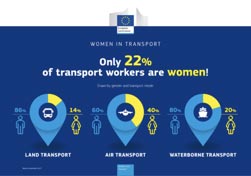 A key element of the TInnGO project is the creation of an Observatory for policymakers, scholars and citizens involved in Smart Mobility, which includes a learning centre, open mobility data platform, data repository, case studies. The Observatory serves as the main dissemination channel for the outputs of the work carried in the project, and as a reference portal on all topics related to gender and diversity sensitive smart mobility. Through this platform, TInnGO is striving to become a community builder and help stakeholders to address local issues of gender and diversity in transport, use tools to combat inequalities, provide national data to back research or support local initiatives, and boost women’s engagement in transport. More information on the Observatory activities can be found at this link: http://transportgenderobservatory.eu/. A key element of the TInnGO project is the creation of an Observatory for policymakers, scholars and citizens involved in Smart Mobility, which includes a learning centre, open mobility data platform, data repository, case studies. The Observatory serves as the main dissemination channel for the outputs of the work carried in the project, and as a reference portal on all topics related to gender and diversity sensitive smart mobility. Through this platform, TInnGO is striving to become a community builder and help stakeholders to address local issues of gender and diversity in transport, use tools to combat inequalities, provide national data to back research or support local initiatives, and boost women’s engagement in transport. More information on the Observatory activities can be found at this link: http://transportgenderobservatory.eu/.
TInnGO project has received funding from the European Union’s Horizon 2020 Framework programme for research and innovation under grant agreement no 824349.
For further information on TInnGO project: https://www.tinngo.eu/
|
Trustonomy

Autonomous driving: will people trust the autonomy?
The Trustonomy European project is at work for answering the question and to investigate technical aspects linked to autonomous driving, involving 16 partners from all over Europe.
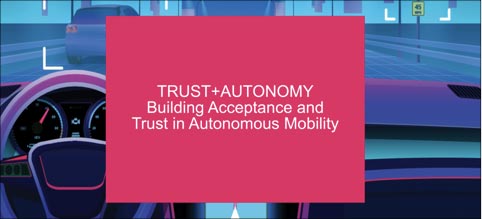
Kicked off in May 2019, within the Horizon 2020 Research and Innovation programme from the European Commission, Trustonomy (a neologism from the combination of trust + autonomy) wants to raise the safety, trust and acceptance of automated vehicles by helping to address technical and non-technical challenges through an integrated and inter-disciplinary approach, bringing experts and ordinary citizens to work closely together. Therefore, Trustonomy will investigate, setup, test and comparatively assess, in terms of performance, ethics and acceptability, different relevant technologies and approaches in a variety of autonomous driving scenarios, covering different types of users, road transport modes, levels of automation, driving conditions.
After one year of work, Trustonomy has analysed the overall operational context of automated driving, including regulatory frameworks, operational barriers, existing solutions and expected trends, both at technological and market levels, setting up the stage of the project.
Trustonomy also carried out preliminary research to define the user requirements, focusing on the scenario known as “Request to Intervene”, whereby a driver is required to take manual control back of a previously automated vehicle. A survey was undertaken to explore what characteristics/design considerations are important to users, with respect to the amount of trust they would have in this type of scenario.
After that, methodological guidelines and the modular architecture were defined, respectively to determine the questions to be investigated during the entire project; and to provide a conceptual specification of the solution: actors and roles, process models showing interactions, conceptual information models and open services that support interoperability between loosely coupled systems.
At the moment, Trustonomy is especially focused on the design of preliminary and final specifications, a key work involving almost the whole consortium. Project pilots, mainly devoted to the analysis of user’s acceptance of and trust in autonomous driving systems, are taking shape as well, and preliminary trials will start in the coming months, compatibly with the Covid-19 emergency.
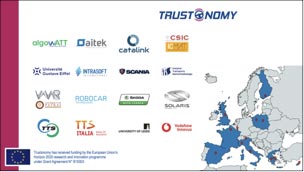
Besides the 16 stakeholders directly involved within the consortium from several European countries, the project is supported by an Advisory Board, which includes external experts providing strategic oversight, considering business and technical perspectives, and actively contributing to the project evolution. At the moment, the Trustonomy Advisory Board includes: Austriatech, ERTICO, Iveco, Toyota, Czech Transport Research Centre, UnipolSai.
Read our second newsletter here and subscribe here.
For further information: https://h2020-trustonomy.eu/
Laura Franchi – redazione@ttsitalia.it

|
Vem Solutions
How was the mobility of Italians after 4 May - research by Vem Solutions (a Viasat Group company)

There are numbers that, more than others, manage to describe a phenomenon of great and dramatic relevance. An example is the study developed by VEM Solutions - Viasat, in collaboration with YouTrend, to reconstruct in detail the dynamics and trends of the movement of cars and commercial vehicles between the lockdown and Phase 2. An observation that allows us to understand how and how much the Italians moved in the blocking period and in the first week of the restart.
VEM Solutions manages one of the most relevant and consistent satellite info-telematic database in Europe: over 780 thousand vehicles connected at European level, including private, light and heavy commercial vehicles, 14 million connected people (apps, wearable devices, workforce management), 1,600 municipalities connected with intelligent transport systems (Smart Cities), 2,600 connected buildings. These numbers represent a projection of the data as at 31.12.2019. This database is powered by information systems for the real-time collection of mobility data, journeys traveled, georeferenced data of holes and bumps, weather information, and integrated data from various sources, managing around 18 billion locations every year in Italy. The analysis was carried out by observing the dynamics of spatial and temporal mobility, as a daily average, projecting the data of the statistical sample, aggregated and anonymized from a GDPR perspective, on the Italian car fleet (source: ACI 2019).
We can say that we are witnessing a real redesign of Italian private and commercial mobility. Some of the data that characterized this period: halving traffic in the lockdown weeks (from an average of 28 million cars to 13 million); there was a 53% increase starting from May 4 compared to the previous month. Another interesting metric, analyzed through the research data, is the kilometers traveled: even these more than halved (the average distance of 80 km dropped to 32 km during the lockdown). The situation is different, however, for trucks whose daily travel has increased, since transport activities have always been guaranteed.
The research continues further, always analyzing the data between private and heavy vehicles, with the projection divided by Regions both on the number of vehicles in circulation and on the distances traveled.
For further information, you can view the complete study at the link here
Info: www.vemsolutions.it |
|
|
|
|
|
|
Covid-19 phase 2: Swarco’S response to public transport needs

March 11th, 2020. The World Health Organization classifies COVID-19 as a pandemic. This has had a very serious impact on the public transport sector.
Big worries are also related to the so called “re-opening” phase. There will be a lack of trust from users, due to the complexity of ensuring safety distances.
Swarco proposes a new solution to reorganize public transport service, which ensures a minimum risk of infection among passengers and between driver and passengers. Swarco new public transport concept monitors in real time the attendance of buses and bus stops, to act in case of critical situations.
The concept is designed also for passengers. They will be real-time informed about occupancy level of buses, so that they can plan their movements.
Purposes of Swarco new Public Transport system are:
1. Management and monitoring of buses occupancy level:
- to highlight occupancy level to the driver, detected by counting systems;
- to offer an integrated tool for the selection of occupancy level by the driver;
- to display occupancy vehicle level of occupancy to control centre operator;
- to send information on vehicle occupancy levels to external systems.
2. Passenger counting systems integrated with AVM or in stand-alone mode;
3. Occupancy level detection through Artificial Intelligence, based on video streaming analysis (using on-board CCTVs);
4. Body temp and PPE detection;
5. Bus Occupancy Level displayed on bus stop signs.
SWARCO MIZAR’s board states: “in this particular moment, our aim is to be able to contribute to the prevention of the widespread outbreak. We want to keep safe our families and friends”. |
S*GATE by Sinelec for road operators

Getting highly accurate vehicle detection and classification is a key challenge for road operators. The performance of legacy free flow tolling systems may decrease in bad weather conditions, poor light and congested traffic, requiring a high back office effort to manage missed detected data and complete the tolling process.
S*GATE is the next generation open road tolling solution, an adaptive smart system for multiple tolling context, strongly based on AI, 3D object tracking and machine learning technologies, to guarantee the highest level of accuracy in vehicle detection and classification in any condition.
 S*GATE innovation comes indeed from the combination of AI and 3D vehicle tracking applied to real-time video streams analysis, delivering the detection of the digital fingerprint of any transit. Sinelec partnership with Sprinx Technologies, a software company for intelligent transportation industry, allows this solution to provide the highest level of insight and valuable information. Renato Clerici, President and CTO of Sprinx Technologies explains that by leveraging Artificial Intelligence and deep learning algorithms, specifically trained for detecting vehicles in thermal images, it is possible to identify the position and type of objects present in the field-of-view of the cameras. “In addition to this phase of video analysis, three-dimensional modelling techniques have been implemented. Knowing the information about camera position and angle, the system is able to reconstruct the trajectory covered by the vehicles, estimating their dimensions and volume” he adds. S*GATE innovation comes indeed from the combination of AI and 3D vehicle tracking applied to real-time video streams analysis, delivering the detection of the digital fingerprint of any transit. Sinelec partnership with Sprinx Technologies, a software company for intelligent transportation industry, allows this solution to provide the highest level of insight and valuable information. Renato Clerici, President and CTO of Sprinx Technologies explains that by leveraging Artificial Intelligence and deep learning algorithms, specifically trained for detecting vehicles in thermal images, it is possible to identify the position and type of objects present in the field-of-view of the cameras. “In addition to this phase of video analysis, three-dimensional modelling techniques have been implemented. Knowing the information about camera position and angle, the system is able to reconstruct the trajectory covered by the vehicles, estimating their dimensions and volume” he adds.
The adoption of advanced video analytics technology optimizes both performance and Total Cost of Ownership since S*GATE requires less field equipment reducing procurement, installation and maintenance costs.
Open to the integration with other devices, all overhead - no inroad sensors required, the system is natively designed for maintainability, thanks also to its simple configuration “plug&toll” capabilities to reduce operational efforts over time.
A typical road installation consists in a dual thermal camera, a dual license plate reader camera and one ETC antenna setup per lane on the gantry, managed by the base portal controller equipped with a hi-performance edge server cluster.
Information embodied in the digital vehicle fingerprint are manifold:
• shape, size and volume (volumetric classification)
• front and rear license plates
• manufacturer, model and color
• EFC tag
The digital fingerprint is correlated with the physical trajectory followed in correspondence of the detecting point, timestamped and referred with GNSS position data, then issued by an encrypted protocol to a custom data lake for further analysis. The algorithm that generates the toll transaction, also created on machine learning and AI models, reaches excellent performances and minimizes the back-office re-processing.
A further innovative S*GATE feature is the great flexibility of its software components, through which it can be easily and quickly adapted to different gantry and sensors configurations, satisfying any customer needs. Pietro Contegno, Sinelec Head of Tolling and Access Control, highlights how “the modular architecture of the software, entirely based on Docker microservices, allows to model system functionalities in a simple and effective way, always guaranteeing optimal performance in determining the digital fingerprint and the creation of toll transactions”.
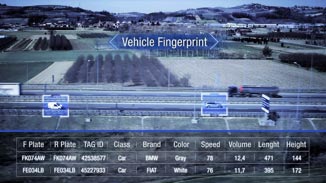 Each gantry toll zone controller provides a simple and intuitive web interface to easily perform both daily and diagnostic activities, with following automatic reconfiguration of replaced components. Being a web application with responsive architecture, it can be accessed with any device, anywhere. Each gantry toll zone controller provides a simple and intuitive web interface to easily perform both daily and diagnostic activities, with following automatic reconfiguration of replaced components. Being a web application with responsive architecture, it can be accessed with any device, anywhere.
The same web interface is adopted for the Toll Collection System Host, where the main toll data elaboration processes are executed, from data acquisition for transaction control and data exchange with commercial backends or external interfaces, up to the transaction review and reconciliation. Collected data are totally privacy-safe and secure: anonymized at the source, they are transmitted to the host through secure interfaces and stored in hardened data structures to preserve their integrity.
S*GATE provides comprehensive reporting tools, including a wide set of KPIs that are constantly monitored and displayed on a graphical dashboard, ensuring a clear and detailed “at-a-glance” overview of the toll collection process performance. Reports can be custom designed, according to the imprinting of immediacy and ease of use that features the entire system, whose complexity is effectively hidden by a user-friendly front-end.
For more information: info@sinelec.it
|
Tattile Vega camera plugin allows integration in Milestone XProtect Smart Client

For today’s needs in monitoring traffic flow, toll enforcement and road incidents modern intelligent traffic systems (ITS) require both powerful hardware with camera systems capable to operate in any outdoor conditions and top-performing software solution to analyze all possible aspects of the images recorded by the cameras. Video management systems (VMS) with the flexibility to upgrade and add functionality such as provided by Milestone as an established supplier have become the preferred software choice for ITS operators to manage video data from any kind of traffic monitoring.
By combining the best in class hardware and software for ITS applications Tattile with its camera competence for outdoor traffic applications has concluded a common software development to fully integrate its Tattile Vega cameras with the Milestone XProtect Smart Client. The Tattile - XProtect Integration Plugin is a fully developed plugin to integrate the Tattile VEGA ANPR Cameras into Milestone XProtect enabling ITS operators to easily incorporate any number of VEGA cameras to automatically communicate with the Milestone VMS.
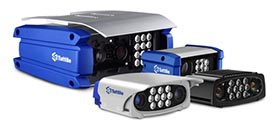
The Tattile Vega plug-in for Milestone XProtect Smart Client is certified by Milestone and is the result of two leading brands in the ITS sector joining forces. It allows users to draw on the multiple functionalities that come with the Tattile VEGA cameras. They not only receive and collect all the events from Tattile’s cameras but also manage previously uploaded number plate lists e.g. from violators and generate alarms; filter options on events and diagnostics; and making use of the Tattile Rigel real time traffic analyzer possibilities able to manage alarms and notifications triggered by a comprehensive list of traffic events. Beyond the precise ANPR-functions filters can be set in the VMS on analyzing the Tattile camera events by date/time of event; single/multiple camera events; vehicle class, brand, color and even vehicle model; as well as plate region, country and plate color.
In addition, the data generated by Tattile cameras is available in the Milestone VMS for any possible post-process analysis of the images. Video sequences can be reviewed, and all recordings are stored. The Tattile Vega plug-in for Milestone XProtect Smart Client can be requested in the Milestone XProtect or via Tattile Sales Rep.
For more information and contacts:
Fabio Boiani - South Europe Regional Manager
f.boiani@tattile.com and visit www.tattile.com |
|
|
|
|
|
|
5T: mobility in Turin during first days of Phase 2
Thanks to the data collected and processed by the Mobility Center, managed by 5T, TTS Italia ordinary member, on behalf of the Municipality of Turin, it is possible to outline a general picture on the trend of mobility in Turin detected in the first 3 days of Phase 2, from Monday 4 May to Wednesday 7 May 2020. The data were compared with the corresponding days of the previous week (blocking period in which the restrictive measures on travel were in force) and with those of the month of May 2019 (6-8 May 2019, considered as "normal" and homogeneous period). As regards traffic, the flows recorded by the sensor network located throughout the urban area were 36% lower than those recorded in 2019. If we analyze the peak hours, in the two peak bands (7.00-9.00 and 17-19.00), the decrease was 50%. Compared to the previous "lockdown" week, traffic increased by 35% with a peak of 39% in the morning rush hour and 68% in the evening rush hour.
The data on cycling flows are very interesting, measured thanks to the sensors of the Handshake project of the City of Turin and 5T. In the first 3 days of Phase 2, there were in fact a total of about 18,000 passes against the 4,000 of the previous week. The cycling flows detected in these days do not reach the levels of 2019, remaining still 52% lower but certainly record a significant leap forward compared to last week with an increase of 335% and with significant peaks in the morning peak hours (+ 478%) and in the evening (+ 460%). Not insignificant data if one considers that some of the cycle paths examined are connected to the main university poles of the city, at this moment still closed and not frequented by their students.
Transits inside the Central LTZ still remain negative: -60% compared to the same days in 2019. While they increased by 47% compared to last week.
Finally, a final figure on the occupation of the 34 car parks located in the city: compared to 2019, the average occupation decreased by 42% while there were no significant changes compared to last week (-2%).
Source: 5T |
algoWatt: Safe public transport in Phase 2 COVID-19, with 3 new proprietary emobility as-a-service solutions
algoWatt, GreenTech Solutions company listed on Borsa Italiana's electronic stock exchange (MTA), and TTS Italia ordinary member, announces that it has started the marketing of three solutions for the management of flows on urban public transport lines, starting from its proprietary platform eMaaS. The management of public transport and safe travel during Phase 2 of the COVID-19 pandemic emergency is one of the most important issues in our country. algoWatt has developed a series of solutions to meet the needs to manage the next evolution of mobility in compliance with the regulations and directives that will be issued.
In particular, algoWatt has deployed three different solutions that can be used individually or merged into the Hybrid Local Public Transport (H-LPT) platform. Let's see in detail what this is all about:
eMaaS - Urban Safety Bus
The target of this solution is to allow the user to choose the least crowded bus to travel. algoWatt proposes an app that represents the solution for the user, for:
• Pre-trip: know the flow indexes for transport lines in order to plan during the day the best moments to take public transport. Based on the choice of the colour of the chosen time slot, the information functions of the "occupation" status of the vehicle are shown.
• On-trip: the app provides information on the state of presence of passengers inside the vehicles, providing a real time overview of available seats.
• The system collects and integrates the position data of the vehicle and the number of presences on the vehicle at the previous stop (counting inputs and outputs if the passenger counting system is active).
• It transmits the data via the app to the user at the stop who can evaluate the capacity of the vehicles (Counter) that will have to travel that route in the next half hour (AVM).
• The app provides graphic information on seat availability (red, orange, green light) and number of seats available.
• Passenger counter system to manage the number of seats occupied in real time with precision
• Deep learning algorithms to "train" to assess the degree of crowding at the stops and manage the most crowded lines
• Interaction based on statistical data on main "nodes" / in and out of the medium in a time range
• The algorithm learns and self learns on the basis of data that it receives to give an increasingly correct estimate.
eMaaS - Demand Responsive Transport
The objective is to guarantee the distance between seats and the reservation of the vehicle to achieve user satisfaction and safety. algoWatt proposes a solution that allows:
• Enhancement of on-demand services, through the eMaaS PersonalBus® software;
• The product allows you to: limit the number of seats on the vehicles, reserve seats and manage impromptu
• PersonalBus add-on for seat reservation via APP and/or call-center and electronic ticket issuance.
• Replacement of fixed lines with flexible routes or addition of vehicles for flexible transport service, in parallel to the line service
• Alternative race management through the Fixed Line Deviation (LFD) algorithm with GTFS import
eMaaS | Hybrid Local Public Transport
The objective of the latter solution is to offer a complete platform for the safety of people and the efficient management of local public transport. algoWatt has integrated the two previous solutions, Urban Safety Bus and Demand Responsive Transport, which merge into the Hybrid Local Public Transport platform, in order to meet the needs of both transport operators and users. In particular, through the platform is possible:
• Booking of fixed lines (in place of or in addition to urban lines)
• Android/IOS App (preferred by younger users)
• Call-center (preferred by older users)
• Electronic Ticket Issue/QRCode or reservation code
• Numbers of seats available on the vehicle provided to the user by means of:
• Mobile application
• Electronic stop pole
• Status of "occupation" guaranteed by the passenger counting system or by the management of bookings only (only in the case where there are no extemporaneous, i.e. unbooked users).
• Smart race management through static (and/or dynamic) GTFS import.
• No map import or complex system.
• Control of ascents and descents thanks to:
• Controller app (smartphone/tablet) to display, in real time, the booked users, enforce the ascents/descents and unblock reservations, or
• If provided, turnstiles on board to ensure that electronic ticket or electronic reservation (eMaaS App) holders can get on/off, or
• On-board device (tablet/smartphone) for the driver, to manage the ride and user operations
The platform allows, on the one hand, user satisfaction (no waiting and safety of the reserved seat) and, on the other hand, company satisfaction (fleet optimization, seat spacing, minimizing queues at the stop, continuity of service).
For information email to: commerciale@algowatt.com
Source: algoWatt |
Fit Consulting: webinars to share strategic analysis and studies
Fit Consulting, socio ordinario di TTS Italia, ha organizzato un ciclo di webinar settimanali accessibili
Fit Consulting, TTS Italia ordinary members, has organized a cycle of weekly webinars accessible for free to provide its contribution by sharing analysis and studies on topics of strategic interest.
The Webinar cycle started on May 15 with a first appointment on the opportunities offered by the growth of the e-commerce channel. The second appointment will deal with the future of people mobility and in particular the impact on the automotive sector, then Fit Consulting will explore a third topic related to the tools to manage the demand for post COVID-19 international logistics and market opportunities.
In order to provide a useful service to operators in the sector, Fit Consulting is available to investigate topics reported on demand. To request the inclusion of specific themes in the program, just send an email to info@fitconsulting.it with the subject Training.
To register, click here
Source: FIT |
Geotab study: Replacing gas cars with electric could save more than 40 tons of CO2 emissions per car
Decarbonization — the reduction of carbon — is an important part of the fight against climate change. The transportation sector in particular, since it is a large source of greenhouse gas emissions, is one area where cutting carbon can make an impact. In the U.S., the transportation sector produces 29% of total greenhouse gas emissions, and in the EU, that figure is 27%. An effective long-term strategy for curbing CO2 emissions is to switch from gasoline and diesel -powered vehicles to electric vehicles (EVs).
Major cities have taken serious steps to facilitate the EV transition. Last December, for example, Madrid hosted the Climate Action Summit, in which companies and governments committed to electrifying their fleets by 2030.
Nevertheless, there are still certain obstacles to carrying out this change. According to PONS and LUIKE’s study VIII Estudio sobre seguridad de las flotas conectadas y las flotas compartidas, the main obstacles towards fleet electrification are price, battery range and charging infrastructures.
Geotab, TTS Italia ordinary member, carried out a global study on the likelihood of fleets going electric today, based on 18 months of connected vehicle data.
The main goal of this study was to look for the best electric vehicle alternative to each internal combustion vehicle considering that the vehicles drive a shorter distance than what the battery range allows them to in the worst conditions.
In a period of time of 18 months Geotab calculated how many kilometers each vehicle drives daily, compared the figure to the specs of current available EV models worldwide, and then made recommendations for electric vehicles that could perform their necessary daily routes on a single charge, charging overnight.
The study found out that in these conditions, almost 8% of the vehicles in the study could be substituted today by electric vehicles, resulting in significant cost savings. This percentage could increase up to 21% if these vehicles could be charged during the day for the 5% of the days with the longest travel.
The economic and environmental impact of electrification was also analyzed. If these vehicles had a lifespan of 200,000 km or 7 years, as compared to an internal combustion vehicle, in the majority of cases, switching to an electric vehicle would lead to savings between 9000 and 18000 Euros per vehicle.
Moreover, if we take into consideration that burning one liter of gasoline produces approximately 2.3 kg of CO2, if the study were put into practice in Spain, there would be a reduction of 41 tons of CO2 per substituted vehicle.
Canada and the U.S. would reduce more than 50 tons of CO2 per vehicle if they went for the electric alternative. According to this study, the average CO2 savings worldwide would be over 40 tons per vehicle. Chicago and New York would be among the cities that would obtain the most benefits, while vehicles in Madrid and Barcelona would reduce around 40 tons per vehicle.
This study is a large-scale version of one of the latest solutions available for Geotab customers: the Electric Vehicle Suitability Assessment (EVSA). This tool helps companies make data-based decisions on which vehicles to substitute for electric vehicles.
The EVSA looks at telematics data collected by the existing fleets, and highlights opportunities for switching to electric vehicles when an electric vehicle can fulfil the daily driving range requirements as well as achieve lifetime cost savings compared to a fuel-powered vehicle.
In conclusion, this study carried out by Geotab shows that there is a large quantity of internal combustion vehicles which could be substituted by electric vehicles right now without having to worry about battery range. We expect that the optimal percentage change in this study will grow rapidly in the next few years as new models become available and due to government support and to the constant innovation and battery improvement in this flourishing sector.
For further information, click here
Fonte: Octo Telematics |
OCTO for the “New Normal”: IoT solutions to protect customers and the workforce
OCTO, a market leader in providing smart solutions, and TTS Italia ordinary member, by transforming its IoT Big Data set into actionable intelligence for a sustainable connected life. OCTO announces the launch of two products designed to support companies return back to business as they transition to the “new normal” following the COVID-19 pandemic. These innovative solutions encourage safe self-distancing and the robust sanitization of vehicles. At the forefront of the design principals, OCTO developed products are easy to implement and manage, while being highly effective. Protecting the workforce and their livelihoods, as well as protecting customers and fostering higher levels of trust.
OCTO AroundMe is based on OCTO’s proven SmartTag technology that utilises the latest Bluetooth standards, OCTO’s IoT cloud platform and is compatible with both iOS and Android smartphones. OCTO AroundMe allows for easy management of social distancing in both public and private spaces, such as stores or office buildings. The pocket-sized SmartTag carried by visitors or employees continuously monitor an individual’s proximity, in this case and under government guidelines this has been automatically set to two metres. Should two people inadvertently have a distance less than two meters apart, an audible alert would remind them to keep a safe distance. The event would also be captured anonymously and stored on the cloud for reporting and analysis, to better understanding and mitigate future risk. To further mitigate any risks, using OCTO AroundMe within closed environments also allows for easy and effective crowd control and building capacity management as it stores all entry and exit information.
OCTO PurePlace uses nano technology originally developed by the National Aeronautics and Space Administration (NASA), that eliminates viruses, bacteria, fungi as well as odours and volatile organic compounds in the air and on surfaces via a purifier. It is a non-invasive solution, safe to people and all materials commonly found within vehicle interiors. As well as the purifier device, the complete OCTO PurePlace solution consists of an onboard telematics device (OCTO SmartDiag or OCTO SuperEasy) and an application compatible with iOS and Android smartphones.
OCTO PurePlace has been designed to protect drivers and passengers across corporate fleets, rental fleets, carsharing and taxi operators. It allows for the easy and effective sanitization of vehicles during a trip with intermittent self-activation and the end of each journey with a full sanitization cycle. To ensure absolute safety and confidence, before entering the vehicle, both the driver and passenger can be notified regarding the state of sanitization via a smartphone app. For the operator and the safe management of the fleet, if the sanitization is not complete, the vehicle may be temporarily suspended from public use.
For further information, click here.
Source: Octo Telematics |
Scania's Science Based Targets are now approved
As the first major manufacturer of heavy commercial vehicles, Scania’s far-reaching climate targets have officially been approved by the Science Based Target initiative (SBTi). Scania, TTS Italia ordinary member, is committed to achieving the Paris agreement goals of limiting global warming to 1.5°C above pre-industrial levels.
Scania will cut CO2 emissions from its own operations by 50 percent by 2025 1, and reduce emissions from its products by 20 percent during the same period.
"Since more than 90 percent of the CO2 emissions generated in our business occurs after the products leave our factories, it is imperative that we also consider these emissions. Limiting ourselves to only reducing our own emissions is simply not enough. We will therefore work in close cooperation with our customers in operating their trucks, buses and engines with less climate impact," says Scania's President and CEO Henrik Henriksson.
The SBTi approval recognises that Scania’s targets align with the most strict decarbonisation pathway defined to date – 1.5°C for Scope 1 and 2. The targets that Scania has set include both direct and indirect emissions from its operations (Scope 1 and 2), as well as emissions from when the products are in use (Scope 3).
"We congratulate Scania for their commitment to take the urgent action needed to address the climate crisis," said Alexander Farsan, global lead for Science Based Targets at WWF, one of the Science Based Targets initiative (SBTi) partners. "They are the first heavy commercial vehicle manufacturer to set an ambitious 1.5°C target through the SBTi and commit to reducing emissions not only from their own operations, but also from the use of their vehicles."
"Science is today clear that our future on Earth depends on holding global warming well-below 2°C, which means cutting emissions by half every decade. Science based targets are critical to succeed in this endeavour. Heavy transport is a backbone of our societies, and Scania's commitment to science based targets for climate, along its entire value chain, will not only contribute to reduce climate risks, but will also send a strong signal through the economy, that decarbonising is real, is now, and constitutes an investment in future competitiveness", says Johan Rockström, professor in Earth system science, and Director of the Potsdam Institute for Climate Impact Research in Germany.
Over the past several years, Scania has significantly reduced CO2 emissions from its own operations and from its own transport and logistics. Scania has also worked to minimise emissions from its products through fuel efficiency measures. Since more than 25 years, the company has provided the industry’s broadest range of products that run on alternatives to fossil fuel. In September 2019, Scania announced its aim to set Science Based Targets. The approval of these targets now marks another major milestone on the journey towards fossil-free transport.“Regardless of whether we, as at present, are in the midst of a crisis or not, we will not compromise on sustainability. Driving the shift towards a sustainable transport system is Scania’s purpose and we remain fully committed,” says Henriksson.
Source: Scania |
Targa Telematics appoints new Corporate Fleet Europe Sales Director Roberto Moneda and further enhances its London office
The Italian firm Targa Telematics, providing solutions in telematics, smart mobility and digital IoT to enable companies, organizations and communities to embrace the revolution of connectivity, and TTS Italia founding member, appoints Roberto Moneda as Corporate Fleet Europe Sales Director as effective from February 2020.
Former professional journalist with a degree in Philosophy and a Masters in Marketing and Communications, Roberto Moneda boasts a 20-year experience in the field of sales and marketing, with former significant experiences in big names of the hi-tech field such as Pioneer and Sony. Between 2011 and 2020, Moneda held several executive roles in an international company with a presence in fleet services market.
“I am keen to join a firm leader in providing digital solutions such as Targa Telematics and I look forward to embracing this new challenge and taking charge of the sales in Europe”, comments new Corporate Fleet Europe Sales Director Roberto Moneda.
Alberto Falcione, Vice President Sales at Targa Telematics, says: “Given his insight and experience in the sector, we are proud to have this new asset in our team. Thanks to his appointment, we are sure Targa Telematics will be thriving and further developing its business not only in Italy but also in core relevant markets abroad such as the United Kingdom and France
Moreover, Targa Telematics opened a new London-based office in November 2019 in order to strengthen its business in this key market. The London-based team is responsible for commercial and after sales activities in the automotive telematics’. The Italian firm is also working on the opening of a new office in Madrid, Spain.
Source: Targa Telematics |
|
|
|
|
|
|
In June the 3° ITS Ibero-American Congress: TTS Italia among participants
The III Ibero-American ITS Congress will take place online from 1 to 3 June, sponsored, among others, also by TTS Italia.
The event will discuss about:
- ITS for public transport
- Smart Cities
- ITS for the management of parking areas
- Management of extra-urban traffic
- ITS for tunnels
- ITS for highways
- Connected and intelligent vehicles
- MaaS
- ITS for the environment (emission control)
- ITS for logistics
- Big Data and mobility
- ITS solutions for COVID-19
TTS Italia will be present with a message from the President, Rossella Panero.
For more details on the event and the program, click here
To register, click here |
The lessons learned in the days of Covid19 in transport: the interview of the President of TTS Italia
What have been the impacts on public and private mobility in the Covid19 emergency period, what to expect in the restart phase and what lessons have we learned from this situation? What are the opportunities that are opening up today for mobility operators, with which resistances and legacies of the past will we still have to deal? The President of TTS Italia, Rossella Panero, as well as Director of 5T - Services and innovation for
Read the interview here (available only in Italian) |
|
|
|
|
|
|
• Italia-Pescara:
multimedia devices
• Italia-Roma:
data transmission network management and support services
|
• Italia-Roma:
IT services. Consulting, software development, Internet and support
• Italia-Trento:
Telecommunication services, except telephone services and data transmission services
|
|
|
|
|
|
|
|
|
|
|
|
|
|
|
|
|

III Congreso Iberoamericano sobre Sistemas Inteligentes de Transportete
1-3 June 2020 - WEB CONFERENCE
For further information, click here →
Green & Smart Recovery – Mobility 2.0
11 June 2020 - WEB CONFERENCE
For further information, click here →
|
|
|
|